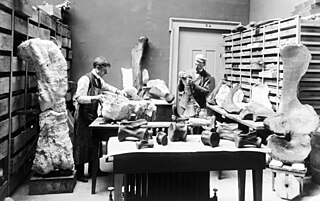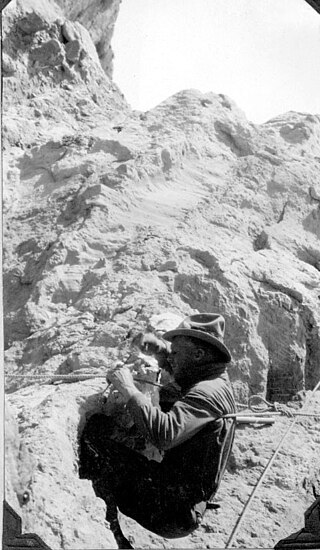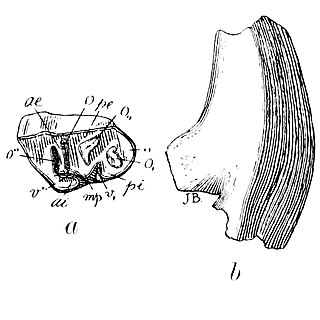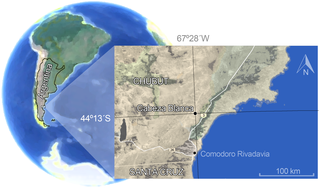
Wilfred Hudson Osgood was an American zoologist.

Thylacosmilus is an extinct genus of saber-toothed metatherian mammals that inhabited South America from the Late Miocene to Pliocene epochs. Though Thylacosmilus looks similar to the "saber-toothed cats", it was not a felid, like the well-known North American Smilodon, but a sparassodont, a group closely related to marsupials, and only superficially resembled other saber-toothed mammals due to convergent evolution. A 2005 study found that the bite forces of Thylacosmilus and Smilodon were low, which indicates the killing-techniques of saber-toothed animals differed from those of extant species. Remains of Thylacosmilus have been found primarily in Catamarca, Entre Ríos, and La Pampa Provinces in northern Argentina.
Karl Patterson Schmidt was an American herpetologist.

Theosodon is an extinct genus of litoptern mammal from the Early to Middle Miocene of South America.

Pyrotherium is an extinct genus of South American ungulate, of the order Pyrotheria, that lived in what is now Argentina and Bolivia, during the Late Oligocene. It was named Pyrotherium because the first specimens were excavated from an ancient volcanic ash deposit. Fossils of the genus have been found in the Deseado and Sarmiento Formations of Argentina and the Salla Formation of Bolivia.

Rhynchippus is an extinct genus of notoungulate mammals from the Late Oligocene of South America. The genus was first described by Florentino Ameghino in 1897 and the type species is R. equinus, with lectotype MACN A 52–31. Fossils of Rhynchippus have been found in the Agua de la Piedra and Sarmiento Formations of Argentina, the Salla and Petaca Formations of Bolivia, the Tremembé Formation of Brazil, and the Moquegua Formation of Peru.

Cramauchenia is an extinct genus of litoptern South American ungulate. Cramauchenia was named by Florentino Ameghino. The name has no literal translation. Instead, it is an anagram of the name of a related genus Macrauchenia. This genus was initially discovered in the Sarmiento Formation in the Chubut Province, in Argentina, and later it was found in the Chichinales Formation in the Río Negro Province and the Cerro Bandera Formation in Neuquén, also in Argentina, in sediments assigned to the SALMA Colhuehuapian, as well as the Agua de la Piedra Formation in Mendoza, in sediments dated to the Deseadan. In 1981 Soria made C. insolita a junior synonym of C. normalis. A specimen of C. normalis was described in 2010 from Cabeza Blanca in the Sarmiento Formation, in sediments assigned to the Deseadan SALMA.

Edmund Heller was an American zoologist. He was President of the Association of Zoos & Aquariums for two terms, from 1935-1936 and 1937-1938.

Andrewsornis is an extinct genus of giant flightless predatory birds of the family Phorusrhacidae or "terror birds" that lived in Oligocene Argentina. Fossils have been found in the Sarmiento Formation, and possibly the Agua de la Piedra Formation.
The South American land mammal ages (SALMA) establish a geologic timescale for prehistoric South American fauna beginning 64.5 Ma during the Paleocene and continuing through to the Late Pleistocene. These periods are referred to as ages, stages, or intervals and were established using geographic place names where fossil materials where obtained.
The Deseadan age is a period of geologic time within the Oligocene epoch of the Paleogene to the Early Miocene epoch of the Neogene, used more specifically within the SALMA classification of South America. It follows the Tinguirirican and precedes the Colhuehuapian age.

Elmer Samuel Riggs was an American paleontologist known for his work with the Field Museum of Natural History in Chicago, Illinois.

Philip Hershkovitz was an American mammalogist. Born in Pittsburgh, he attended the Universities of Pittsburgh and Michigan and lived in South America collecting mammals. In 1947, he was appointed a curator at the Field Museum of Natural History in Chicago and he continued to work there until his death. He has published much on the mammals of the Neotropics, particularly primates and rodents, and described almost 70 new species and subspecies of mammals. About a dozen species have been named after him.

Felipe Mendez was born around 1897 in San Juan, Argentina and participated as a paleontological collector at the 2nd Captain Marshall Field Paleontological Expedition in 1926.

Robert Coin Thorne was an American paleontologist.
Bryan Patterson was an American paleontologist at the Field Museum of Natural History in Chicago.

Pharsophorus is an extinct genus of borhyaenoid sparassodont that inhabited South America during the Middle to Late Oligocene epoch.
The Agua de la Piedra Formation is a Late Oligocene geologic formation of the Malargüe Group that crops out in the southernmost Precordillera and northernmost Neuquén Basin in southern Mendoza Province, Argentina.

Argyrohippus is an extinct genus of notoungulate, belonging to the family Notohippidae. It lived from the Late Oligocene to the Early Miocene, and its fossilized remains were found in South America.

The Sarmiento Formation, in older literature described as the Casamayor Formation, is a geological formation in Chubut Province, Argentina, in central Patagonia, which spans around 30 million years from the mid-Eocene to the early Miocene. It predominantly consists of pyroclastic deposits, which were deposited in a semi-arid environment. It is divided up into a number of members. The diverse fauna of the Sarmiento Formation, including a variety of birds, crocodilians, turtles and snakes, also includes many mammals such as South American native ungulates as well as armadillos, and caviomorph rodents.
















